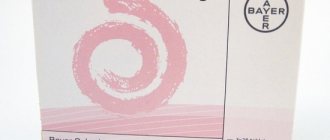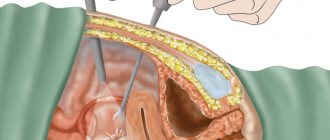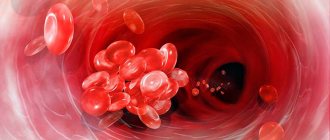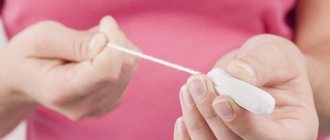Pills
Women of reproductive age face the problem of endometriosis. This pathology significantly reduces the quality of life and is also a significant obstacle to fertilization and the birth of a child.
With this disease, the inflammatory process progresses on the mucous membrane and outside the organ cavity, inhibiting reproductive function.
The process of bearing a child, even if conception occurs, will be complicated, and often ends in miscarriage or fetal death.
In gynecological practice, if we consider conservative methods of treating endometriosis, they practice drug treatment. Doctors often prescribe Lindinet 20 for endometriosis. Let's take a closer look at what Lindinet 20 and Lindinet 30 medications are and how to take them correctly.
General information
Lindinet medications for endometriosis are prescribed by many gynecologists, but the drugs belong to the pharmacological group of monophasic combined oral contraceptives, another name is COCs (combined oral contraceptives). The main active ingredients of Lindinet are ethinyl estradiol and gestodene.
Lindinet 20 and Lindinet 30 - tablets for oral administration, 21 or 63 pieces per box, have different concentrations of estradiol - 20 mcg or 30 mcg, respectively. gestodene is the same - 75 mcg in each pill.
(Hungary).
Drug interactions
A number of drugs reduce the contraceptive activity of hormones. Among them:
- Ampicillin,
- Tetracycline,
- Rifampicin,
- Primidon,
- Carbamazepine,
- Phenylbutazone,
- Phenytoin,
- Griseofulvin,
- Topiramate,
- Oxcarbazepine.
Any drug that stimulates the gastrointestinal tract will lead to a decrease in the concentration of active substances in the blood. The same effect is observed with the simultaneous use of infusions and other products based on St. John's wort.
Is it possible to drink alcohol with Lindinet 20
From a pharmacological point of view, contraceptives are compatible with alcohol. However, the presence of alcohol in the liver affects the pharmacokinetics of the drug and increases the likelihood of side effects.
Properties
The drugs have a depressing effect on the ovulation process. The two components in the body cause interrelated processes. This:
- suppression of ovulation by inhibiting the release of pituitary hormones;
- inhibition of follicle maturation;
- obstruction to the release of the egg;
- increased viscosity of the mucous secretion of the cervix, which makes it difficult for sperm to penetrate into the uterine cavity;
- causes changes in the endometrium and prevents the implantation of a fertilized egg into the uterine mucosa.
A woman who regularly takes COCs will notice a restoration of the cyclicity of menstruation, a decrease in pain and the intensity of blood loss. The risk of iron deficiency anemia with heavy menstruation is also reduced.
If a woman is prescribed Lindinet 30 by a doctor for endometriosis or to prevent an unwanted pregnancy, then before using the drug it is necessary to undergo an examination. These are: a gynecological examination and laboratory tests to determine hormone levels.
Lindinet 20 is prescribed more often for endometrial hyperplasia and endometriosis, since the minimum dose of estradiol is less likely to lead to hormonal imbalance in women. In situations where the level of ethinyl estradiol in the blood is elevated, you need to select another drug.
Drugs for the treatment of endometriosis: the most effective remedies
Endometriosis is a gynecological pathology in which there is a proliferation of endometrial cells outside the uterus. This disease affects women of fertile age. The list of pills for endometriosis is very wide. The choice of medications is strictly individual and should be carried out under the supervision of a physician.
Suppositories are another remedy that is often used to treat endometriosis. Before listing the main names, it is necessary to understand how to properly treat the disease. Endometriosis is very difficult to treat.
Most often, specialists have to combine treatment methods. Drug therapy is necessary to slow down the manifestations of the disease. However, without surgical intervention, it will not be possible to completely get rid of the pathology.
Treatment regimens for the disease
In women over 30 years of age, it is most often necessary to select an individual treatment regimen.
The treatment plan is drawn up based on the following data:
- manifestations of the disease;
- degree of severity of the process;
- the need to preserve reproductive function;
- age;
- individual characteristics of the body;
- gynecological history (particular attention should be paid to patients after medical abortion or other termination of pregnancy).
The “gold standard” in the treatment and diagnosis of the disease is laparoscopic intervention. In severe cases of the disease, only after surgical treatment can one hope for a good effect from drug therapy.
The following drugs are used:
Source: https://Wellness2You.ru/yaichniki-i-matka/lindinet-20-pri-endometrioze.html
Compound
Lindinet 30, reviews of which from women indicate its effectiveness, refers to monophasic oral contraceptives, in which each tablet contains a fixed dose of hormones, regardless of the day of the menstrual cycle.
1 tablet contains the following components:
- Main active substances:
- Ethinyl estradiol (30 mcg) is an artificial estrogen (a group of female sex hormones). It is able to regulate the menstrual cycle of women, as well as influence other processes - the formation of sexual characteristics, increasing blood clotting, and bone strength. It is part of many drugs intended for contraception and replenishing estrogen deficiency.
- Gestodene (75 mcg) is a progestin (a group of steroid hormones that are produced by the corpus luteum of the ovaries), obtained synthetically. In combination with ethinyl estradiol, it leads to a threefold increase in the concentration of proteins in the blood responsible for the binding and transmission of sex hormones. Has high selectivity. It is one of the most thoroughly studied third generation progestogens. It is more effective than the natural hormone progesterone.
- Excipients:
- sodium calcium edetate (0.065 mg) – complexing agent;
- magnesium stearate (0.2 mg) – filler (serves to increase the volume of the product);
- polysorb (0.275 mg) – a complexing agent that attaches hydroxyl groups;
- povidone (1.7 mg) – antiseptic;
- corn starch (15.5 mg) – a thickener used to form tablets;
- lactose monohydrate (37.15 mg) is a pharmacologically inactive excipient;
Lindinet 30
- Components of the shell:
- dyes;
- povidone;
- macrogol 6000 (polymer binder);
- talc (stabilizer);
- calcium carbonate – a component that protects against the effects of aggressive gastric juice;
- sucrose (19.66 mg) – sweetener.
Use of Lindinet 20 and 30 for the treatment of endometriosis
Endometriosis is a gynecological disease caused by hormonal imbalance. If a woman is diagnosed with such a pathology, the doctor prescribes drug therapy. Lindinet for endometriosis helps in the treatment of this disease and prevents the onset of unwanted pregnancy.
Symptoms of endometriosis
Endometriosis refers to an inflammatory process in which the cells of the epithelial layer lining the inner surface of the uterus begin to grow outside the organ.
The main reason for this is hormonal imbalance.
For many women, the disease occurs due to a lack or excessive amount of estrogen, a female hormone that regulates the activity of the reproductive organs.
Endometriosis has no obvious symptoms and is therefore diagnosed only on the basis of a special examination. The disease is not always detected during a gynecological examination. This pathology is characterized by the following signs that appear in any woman suffering from endometriosis:
- infertility;
- pain;
- bleeding;
- Irregular menstrual cycle.
The main cause of infertility with endometriosis is changes in the endometrium, as a result of which a fertilized egg cannot attach to it. Due to hormonal imbalance, which leads to pathological growth and changes in the structure of the endometrium, the production of hormones necessary for the development of pregnancy is disrupted.
Pain in endometriosis is characterized by different localization and intensity. A sharp pain occurs in the lower abdomen, which can be stabbing or cutting. Chronic pain can be nagging or dull. Their intensity is most often moderate, so many women do not attach much importance to them.
Chronic pain with endometriosis increases as a result of:
- intimacy;
- lifting weights;
- menstrual flow.
With this disease, a woman experiences bloody discharge after intimacy. If the pathology has affected parts of the intestines or organs of the genitourinary system, then bloody streaks are found in stool or urine.
Endometriosis often leads to menstrual irregularities. In this case, menstruation may be absent for several months in a row, or prolonged and heavy bleeding may occur.
Indications for use of Lindinet
Lindinet is a contraceptive that inhibits the production of hormones by the pituitary gland. Its main components:
- gestodene;
- ethinyl estradiol.
The drug contains 20 or 30 mg of ethinyl estradiol, so there are 2 forms of the drug: Lindinet 20 and Lindinet 30. The first medication is prescribed more often because it does not greatly change hormonal levels.
The main indication for use is contraception. After taking the drug, the ovulation process is suppressed and egg maturation does not occur.
The vaginal mucus becomes viscous, preventing sperm from entering the uterine cavity.
In addition, the medication is used to treat endometriosis, normalizing the menstrual cycle and preventing the development of many gynecological diseases, incl. neoplasms.
Treatment regimen
Take the drug for endometriosis for a long time. If side effects occur, consult a doctor. He will cancel this remedy or find out the cause of the body’s negative reaction. Sometimes the development of side effects may coincide with an exacerbation of other diseases.
You should take the first tablet on the first day of your period. For 3 weeks, the drug is taken once a day at the same time. After this they take a break for a week. During this period, bleeding often occurs due to drug withdrawal.
On the 8th day of the cycle, take a tablet from a new package. The duration of treatment is the same. Lindinet should be taken for at least 6 months. In some cases, the doctor prescribes it for 12 months or more.
It is forbidden to discontinue the drug without consulting a doctor. The result of treatment occurs as a result of a cumulative effect.
Contraindications
Lindinet has a large number of contraindications. These include:
- venous thromboembolism;
- transient ischemic attack, angina pectoris;
- severe risk factors for venous or arterial thrombosis;
- pancreatitis;
- venous or arterial thromboembolism;
- deep vein thrombosis of the leg, stroke, pulmonary embolism, myocardial infarction;
- neurological migraine;
- prolonged immobilization after surgery;
- diabetes;
- hepatitis, cholestatic jaundice, liver disease;
- jaundice;
- hyperlipidemia;
- liver tumors;
- Gilbert's syndrome, Dubin-Johnson syndrome, Rotor syndrome;
- cholelithiasis;
- pregnancy;
- breast-feeding;
- malignant tumors of the mammary glands or genital organs;
- vaginal bleeding;
- otosclerosis;
- hypersensitivity to the components of the product.
The drug should be taken with caution by women at risk of developing venous or arterial thrombosis. These include the following patients:
- having a hereditary predisposition to thrombosis;
- over 35 years old;
- smokers;
- obese;
- with liver diseases, porphyria, pregnancy herpes, chloasma, arterial hypertension, valvular heart defects.
Reviews
Elena, 36 years old, Saratov: “2 years ago I was diagnosed with endometriosis, and the doctor prescribed the drug Lindinet 20. He said to take it for six months. I was afraid to take hormonal drugs, because... I am overweight.
But the disease had to be treated. In the first month I felt good, only in the first days I felt a little nauseous. On the 4th day after the cancellation, my period came.
In the second month of taking it, I began to notice that I was often in a bad mood and irritability.
This went on for another 2 months, but I started drinking soothing tea. My health and mood have improved. As a result, my periods did not take as long as before, and they became painless. The discharge that was observed with endometriosis has disappeared. The cycle returned to normal. I’m happy with the result and now, after stopping OK, I hope to get pregnant.”
Tatyana, 44 years old, Tver: “A year ago I started bleeding, and I turned to a gynecologist. After examination, he was diagnosed with endometriosis. He prescribed the drug Lindinet 20. I took it for 7 months.
Side effects appeared only in the third month of use: severe headaches and bad mood, similar to depression. But with the help of folk remedies we managed to get rid of such side effects.
I’m satisfied with the result of the treatment: the cycle returned to normal, and there was no more discharge.”
Source: https://venerologia03.ru/matka-i-yaichniki/lindinet-pri-endometrioze.html
Contraindications
This product should not be used in the following cases:
- individual sensitivity to components;
- moderate or severe hypertension (with blood pressure exceeding 160/100 mm Hg);
- tendency to thrombosis;
- violation of fat metabolism, accompanied by the accumulation of lipids in the body;
- diabetic angiopathy;
- heart valve dysfunction;
- vascular diseases;
- atrial fibrillation;
- smoking in women over 35 years of age (consuming more than 15 cigarettes in 1 day);
- the presence of the following pathologies in the patient in the past: acute cerebrovascular accident, ischemic heart disease (angina pectoris), myocardial infarction, embolism of blood vessels (including family cases of the disease), migraine accompanied by local neurological disorders - tremor, dizziness, loss of consciousness;
- pregnancy (or suspicion of it), lactation;
- postoperative period with forced loss of mobility for a long time;
- inflammation of the pancreas, accompanied by an increase in triglycerides in the blood;
- uterine bleeding for unknown reasons;
- hereditary syndromes: Rotor, Gilbert, Dabin-Johnson;
- severe pathologies of the hepatobiliary system - hepatitis, tumors, cholelithiasis, jaundice caused by deterioration of bile excretion or taking medications that contain hormones;
- the presence of malignant tumors, the growth of which depends on the influence of hormones.
This product can only be used under medical supervision, with a careful assessment of the possible risks, in the following cases:
- patients from the age group over 35 years;
- hypertension;
- active smoking;
- arrhythmia and heart valve defects;
- thrombosis, heart attack, stroke in the woman’s relatives;
- pathologies that were first diagnosed or worsened while taking hormones or after pregnancy;
- Quincke's edema in hereditary form;
- lipid metabolism disorders;
- hemoglobinopathies;
- systemic pathologies – hemolytic-uremic syndrome, lupus erythematosus;
- obesity degree I and above;
- diabetes;
- the period after the birth of the child (21 days for non-breastfeeding mothers and the entire lactation period for nursing mothers);
- recurrent headaches of moderate and high intensity;
- seizures;
- liver pathologies;
- varicose veins;
- severe injury or surgery;
- tendency to severe depression;
- inflammatory pathologies of the gastrointestinal tract (Crohn's disease, ulcerative colitis).
Lindinet 30
The drug is contraindicated for use during pregnancy and lactation.
The components of the drug are excreted in breast milk in small quantities.
When used during lactation, milk production may decrease.
Use for liver dysfunction
Contraindicated in cases of diseases or severe liver dysfunction, liver tumors (including a history).
Prescribe with caution for liver failure, cholestatic jaundice (including in pregnant women with a history).
In case of acute or chronic impairment of liver function, the drug should be discontinued until liver enzyme values are restored. If liver function is impaired, the metabolism of steroid hormones may be impaired.
special instructions
Before starting to use the drug, it is necessary to conduct a general medical examination (detailed family and personal history, blood pressure measurement, laboratory tests) and gynecological examination (including examination of the mammary glands, pelvic organs, cytological analysis of a cervical smear). Such examinations during the period of taking the drug are carried out regularly, every 6 months.
The drug is a reliable contraceptive: the Pearl index (an indicator of the number of pregnancies occurring during the use of a contraceptive method in 100 women over 1 year) when used correctly is about 0.05.
Due to the fact that the contraceptive effect of the drug from the start of administration is fully manifested by the 14th day, it is recommended to additionally use non-hormonal methods of contraception in the first 2 weeks of taking the drug.
In each case, before prescribing hormonal contraceptives, the benefits or possible negative effects of their use are individually assessed. This issue must be discussed with the patient, who, after receiving the necessary information, will make the final decision on the preference for hormonal or any other method of contraception.
The woman's health condition must be carefully monitored. If any of the following conditions/diseases appear or worsen while taking the drug, you must stop taking the drug and switch to another, non-hormonal method of contraception:
- diseases of the hemostatic system;
- conditions/diseases predisposing to the development of cardiovascular and renal failure;
- epilepsy;
- migraine;
- the risk of developing an estrogen-dependent tumor or estrogen-dependent gynecological diseases;
- diabetes mellitus not complicated by vascular disorders;
- severe depression (if depression is associated with impaired tryptophan metabolism, then vitamin B6 can be used for correction);
- sickle cell anemia, because in some cases (for example, infections, hypoxia), estrogen-containing drugs for this pathology can provoke thromboembolism;
- the appearance of abnormalities in laboratory tests assessing liver function.
Thromboembolic diseases
Epidemiological studies have shown that there is a connection between taking oral hormonal contraceptives and an increased risk of developing arterial and venous thromboembolic diseases (including myocardial infarction, stroke, deep vein thrombosis of the lower extremities, pulmonary embolism).
An increased risk of venous thromboembolic diseases has been proven, but it is significantly less than during pregnancy (60 cases per 100 thousand pregnancies).
When using oral contraceptives, arterial or venous thromboembolism of the hepatic, mesenteric, renal or retinal vessels is very rarely observed.
The risk of arterial or venous thromboembolic disease increases:
- with age;
- when smoking (heavy smoking and age over 35 years are risk factors);
- if there is a family history of thromboembolic diseases (for example, parents, brother or sister). If a genetic predisposition is suspected, it is necessary to consult a specialist before using the drug;
- for obesity (BMI more than 30 kg/m2);
- with dislipoproteinemia;
- with arterial hypertension;
- for diseases of the heart valves complicated by hemodynamic disorders;
- with atrial fibrillation;
- with diabetes mellitus complicated by vascular lesions;
- with prolonged immobilization, after major surgery, after surgery on the lower extremities, after severe trauma.
In these cases, it is assumed to temporarily stop using the drug (no later than 4 weeks before surgery, and resume no earlier than 2 weeks after remobilization).
Women after childbirth have an increased risk of venous thromboembolic disease.
It should be taken into account that diabetes mellitus, systemic lupus erythematosus, hemolytic-uremic syndrome, Crohn's disease, ulcerative colitis, sickle cell anemia increase the risk of developing venous thromboembolic diseases.
It should be taken into account that resistance to activated protein C, hyperhomocysteinemia, protein C and S deficiency, antithrombin III deficiency, and the presence of antiphospholipid antibodies increase the risk of developing arterial or venous thromboembolic diseases.
When assessing the benefit/risk ratio of taking the drug, it should be taken into account that targeted treatment of this condition reduces the risk of thromboembolism. Symptoms of thromboembolism are:
- sudden chest pain that radiates to the left arm;
- sudden shortness of breath;
- any unusually severe headache that continues for a long time or appears for the first time, especially when combined with sudden complete or partial loss of vision or diplopia, aphasia, dizziness, collapse, focal epilepsy, weakness or severe numbness of half the body, movement disorders, severe unilateral pain in the calf muscle, acute abdomen.
Tumor diseases
Some studies have reported an increased incidence of cervical cancer in women who took hormonal contraceptives for a long time, but the results of the studies are inconsistent. Sexual behavior, infection with the human papillomavirus and other factors play a significant role in the development of cervical cancer.
A meta-analysis of 54 epidemiological studies found that there is a relative increase in the risk of breast cancer among women taking oral hormonal contraceptives, but the higher detection rate of breast cancer may have been associated with more regular medical screening.
Breast cancer is rare among women under 40, whether they take hormonal birth control or not, and increases with age. Taking pills can be considered one of many risk factors.
However, the woman should be made aware of the possible risk of developing breast cancer based on an assessment of the benefit-risk ratio (protection against ovarian and endometrial cancer).
There are few reports of the development of benign or malignant liver tumors in women taking hormonal contraceptives for a long time. This should be kept in mind when differentially assessing abdominal pain, which may be associated with an increase in liver size or intraperitoneal bleeding.
Chloasma
Chloasma can develop in women with a history of this disease during pregnancy. Those women who are at risk of developing chloasma should avoid contact with sunlight or ultraviolet radiation while taking Lindinet 30.
Efficiency
The effectiveness of the drug may be reduced in the following cases: missed pills, vomiting and diarrhea, simultaneous use of other drugs that reduce the effectiveness of birth control pills.
If the patient is concomitantly taking another drug that may reduce the effectiveness of birth control pills, additional methods of contraception should be used.
The effectiveness of the drug may decrease if, after several months of their use, irregular, spotting or breakthrough bleeding appears, in such cases it is advisable to continue taking the tablets until they run out in the next package. If at the end of the second cycle menstrual-like bleeding does not begin or acyclic bleeding does not stop, stop taking the pills and resume it only after pregnancy has been ruled out.
Changes in laboratory parameters
Under the influence of oral contraceptive pills - due to the estrogen component - the level of some laboratory parameters (functional indicators of the liver, kidneys, adrenal glands, thyroid gland, hemostasis indicators, levels of lipoproteins and transport proteins) may change.
Additional Information
After acute viral hepatitis, the drug should be taken after normalization of liver function (no earlier than 6 months).
With diarrhea or intestinal disorders, vomiting, the contraceptive effect may be reduced. While continuing to take the drug, it is necessary to use additional non-hormonal methods of contraception.
Women who smoke have an increased risk of developing vascular diseases with serious consequences (myocardial infarction, stroke). The risk depends on age (especially in women over 35 years of age) and on the number of cigarettes smoked.
The woman should be warned that the drug does not protect against HIV infection (AIDS) and other sexually transmitted diseases.
Impact on the ability to drive vehicles and operate machinery
Studies have not been conducted to study the effect of the drug Lindinet 30 on the abilities necessary to drive a car and operate machinery.
Source: https://ProTabletky.ru/lindynette-30/
Endometriosis and Lindinet 20
Women of reproductive age face the problem of endometriosis. This pathology significantly reduces the quality of life and is also a significant obstacle to fertilization and the birth of a child.
With this disease, the inflammatory process progresses on the mucous membrane and outside the organ cavity, inhibiting reproductive function.
The process of bearing a child, even if conception occurs, will be complicated, and often ends in miscarriage or fetal death.
In gynecological practice, if we consider conservative methods of treating endometriosis, they practice drug treatment. Doctors often prescribe Lindinet 20 for endometriosis. Let's take a closer look at what Lindinet 20 and Lindinet 30 medications are and how to take them correctly.
Use of Lindinet 20 and 30 for the treatment of endometriosis
Endometriosis is a gynecological disease caused by hormonal imbalance. If a woman is diagnosed with such a pathology, the doctor prescribes drug therapy. Lindinet for endometriosis helps in the treatment of this disease and prevents the onset of unwanted pregnancy.
Reviews from experts
Now you know why you need a product like Lindinet 30. The instructions and purpose of this medicine were presented above. What do gynecologists say about him? Most experts leave extremely positive reviews about this medication. They claim that such an oral contraceptive effectively helps resolve the issue of unwanted pregnancy. At the same time, doctors make a reservation that even when taking the correct dosages of the drug and following a strict regimen, the patients’ weight may unreasonably increase, which, of course, cannot but upset them.
Gynecologists also report that, in addition to their main purpose, the contraceptive pills in question are actively used as a therapeutic agent for gynecological pathologies, including functional disorders of the monthly cycle.
Thanks to a carefully developed formula, as well as a thoughtful regimen for taking the contraceptive, you can easily achieve the desired results for a long time. At the same time, gynecologists claim that Lindinet 30 tablets can cause adverse reactions. In this regard, before taking them, you should definitely seek additional advice from an experienced specialist.
Lindinet 20 and Lindinet 30 for endometriosis and endometrial hyperplasia: instructions for use
Women of reproductive age face the problem of endometriosis. This pathology significantly reduces the quality of life and is also a significant obstacle to fertilization and the birth of a child.
With this disease, the inflammatory process progresses on the mucous membrane and outside the organ cavity, inhibiting reproductive function.
The process of bearing a child, even if conception occurs, will be complicated, and often ends in miscarriage or fetal death.
In gynecological practice, if we consider conservative methods of treating endometriosis, they practice drug treatment. Doctors often prescribe Lindinet 20 for endometriosis. Let's take a closer look at what Lindinet 20 and Lindinet 30 medications are and how to take them correctly.
Dosages
Only a gynecologist must determine the individually required daily dose of medication and the duration of therapy.
According to the standard regimen, the first tablet is taken on the first day of the onset of menstrual bleeding. Next, preferably at the same time of day, drink one pill for three weeks (21 days).
After this, a week-long break should be taken, during which the woman experiences menstrual-like bleeding associated with drug withdrawal. Starting from the eighth day, they begin to take tablets from a new blister.
This scheme is followed throughout the course of therapy. The treatment is long-term.
Skipping a pill
To maintain a stable contraceptive effect, you should not skip taking pills. If a woman forgot to take a pill at the usual time and less than 12 hours have passed, then she should take the missed pill, and the next day at the usual time continue treatment according to the usual regimen.
If more than 12 hours have passed, you should immediately take the forgotten pill, even if this means taking two pills at once. It is also recommended to consult a doctor and for the woman to use a barrier method of contraception for the next 10 days.
The treatment interval cannot be extended by more than 7 days.
Carefully
- women who are 35 years of age or older;
- with a congenital predisposition to the formation of blood clots;
- smoking and drinking alcohol;
- depression and the postpartum period.
Adverse reactions
- pain in the lower abdomen;
- breakthrough uterine bleeding or spotting;
- thrombosis;
- arterial hypertension;
- heart attack, stroke;
- nausea and vomiting;
- jaundice;
- skin rash like urticaria;
- hair loss;
- disturbance of the psycho-emotional state, increased irritability, frequent mood swings;
- swelling and tenderness in the mammary glands;
- swelling;
- weight gain;
- increased appetite;
- oncological neoplasms.
Overdose
Manifested by the occurrence of adverse reactions described above. There is no antidote; treatment is aimed at eliminating symptoms.
Drug interactions
COCs affect the liver microsomal system and can change the intensity of action and the rate of elimination of all drugs metabolized in the liver.
Before using Lindinet, you should inform your gynecologist about all medications you are taking. Only he will be able to correctly determine the pharmacological safety of combination therapy.
Conditions of storage and acquisition
The tablets should be stored under standard conditions.
Dispensed from pharmacies with a prescription.
Analogs
- Gestarella;
- Logest;
- Themiss Ginesta and Themiss Ginesta Mini;
- Femoden;
Novinet or Lindinet
Many women wonder which is better for endometriosis, Novinet or Lindinet.
Only the gynecologist leading the patient can give an accurate and correct answer, since one of the active ingredients of the listed medications is different.
It is strictly forbidden to select and take medications based on recommendations from friends and acquaintances. In each clinical case, taking into account the peculiarities of the course of the pathology, the doctor prescribes medications individually.










